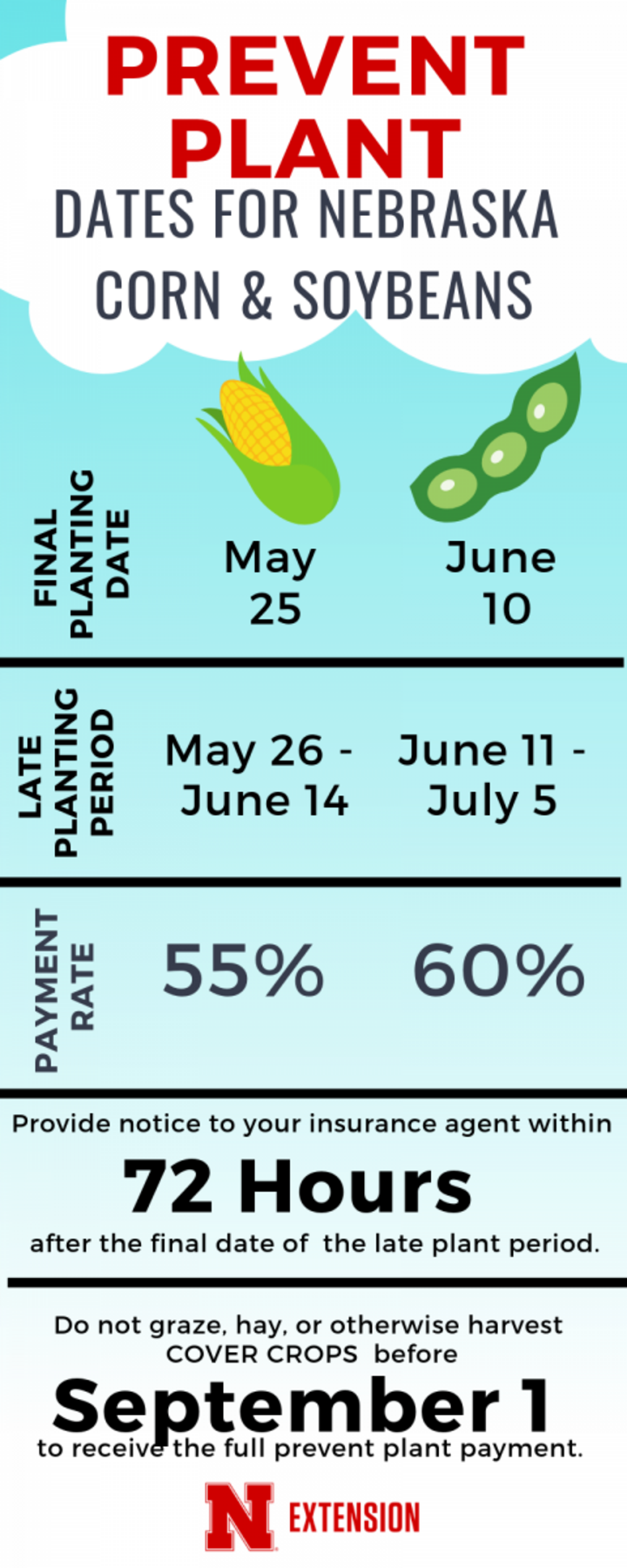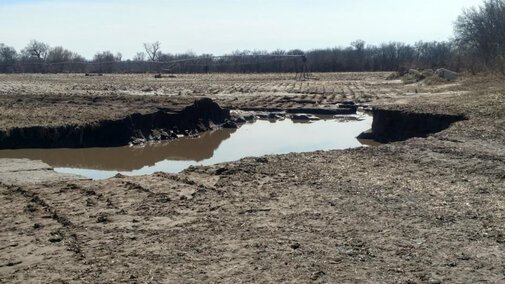April 10, 2019; revised on June 20, 2019 to reflect program changes
Depending on the extent of flood damage on your property, you may qualify for crop insurance prevented planting payments. This article will review the final planting dates and late planting periods, and highlight some unknowns and considerations as you assess the damage to your property.

Prevented planting payments are available for both revenue and yield protections policies, but not for Area Risk Protection Insurance. Eligibility for prevented planting payments will be determined on a case-by-case basis.
2019 Final Planting Dates and Late Planting Dates
For all counties in Nebraska, regardless of flood damage, the final planting date for corn is May 25, and the end of the late-planting period is June 14. The final planting date for soybeans is June 10, and the end of the late-planting period is July 5. Farmers may be eligible for prevented planting crop insurance claims if acres have not been planted by the final planting date of the crop. For a farmer to be eligible for a prevented planting payment, prevented planting must be general to the surrounding area.
According to the Risk Management Agency, “Prevented planting is the failure to plant the insured crop by the final planting date designated in the Special Provisions for the insured crop in the county, or with in any applicable late planting period, due to an insured cause of loss that is general to the surrounding area and that prevents other producers from planting acreage with similar characteristics. Failure to plant because of uninsured causes such as lack of proper equipment or labor to plant acreage, or use of a particular production method, is not considered prevented planting.”
The severe flood has caused extensive damage to some farms. Farms may be eligible for prevented planting payments based on inability to farm the ground due to silt/sand/debris deposits, inability to enter the farm property from damaged roads and entries, and damaged irrigation systems or wells. Regardless of the reason you are claiming prevented planting, keep detailed records of the event. Records include pictures of the damage and any seed/chemical/fertilizer orders that were in place to show original intention to plant the acres.
The prevented planting payment is 55% of the final guarantee for corn and 60% for soybeans.
If you are prevented from planting, and you do not intend to plant the crop during the late planting period, you need to provide notice to your insurance agent within 72 hours after the final planting date.
Example of a Prevented Planting Calculation
A farm has a Revenue Protection policy with a 75% coverage level. The 2019 projected price for corn is $4 per bushel. A farm with a 200-bushel Actual Production History (APH) would guarantee this farm $600 per acre (200 bushels X 75% X $4.00). If the farm qualified for a prevented planting payment, the payment would be $330 per acre ($600 X 55%).
Late Planting
Farmers can plant a crop after the final planting date and still receive crop insurance coverage. However, the crop insurance coverage will be reduced 1% per day after the final planting date, for 25 days (the late planting period). You are not obligated to plant in the late planting period.
| Corn | Soybean |
|---|---|
| March 15 — Sales closing date | March 15 — Sales closing date |
| April 10 — Earliest planting date | |
| April 25 — Earliest planting date | |
| May 25 — Final planting date | |
| June 10 — Final planting date | |
| June 14 — Late planting period end date | |
| July 4 — Late planting period end date | |
| September 1* — Cover crop grazing/haying cutoff date | September 1* — Cover crop grazing/haying cutoff date |
| *On June 20, 2019 RMA revised the deadline to September 1, after which grazing/haying of cover crops planted on prevented planting acres would be allowed. It had previously been November 1. | |
If you plant during the late planting period, you are not eligible for prevented planting payment.
If you cannot plant during the late planting period, you need to provide notice to your insurance agent within 72 hours after the final date of the late plant period.
Unknowns
Farmers who have existing or “carryover” policies may qualify for prevented planting payment as a result of the flooding.
The bigger question is for new insureds. The crop insurance sales closing date for corn and soybeans in Nebraska was March 15. Insurance coverage for a new insured does not begin until the sales closing date. Insured causes of loss occurring before this time, are not covered. Depending on the location of the farm, this sales closing date could have occurred after the flooding event. Farmland with new policies may not be eligible for crop insurance indemnities related to the flooding.
Considerations for 2019
Leave ground idle. After notifying your crop insurer of a prevented planting situation, you can leave the ground idle until the following crop year.
Planting soybeans rather than corn. If you are unable to plant a corn crop during the corn-planting period, you still may be able to put in a soybean crop. Notify your crop insurance agent of changes of crop planting intentions.
Plant a cover crop. A cover crop can be planted on acres declared as prevented planting. However, to receive the full prevented planting payment, the cover crop cannot be grazed, cut for silage (haylage or baleage), or hayed before September 1 or otherwise harvested at any time. If the cover crop is planted during the late planting period and grazed, cut for silage (haylage or baleage), or hayed before September 1, no prevented planting payment will be made. If the cover crop is planted after the late planting period and grazed, cut for silage (haylage or baleage), or hayed before September 1, you will receive 35% of the prevented planting payment. (On June 20, 2019 RMA made a one-year change to move this deadline from November 1 to September 1.)
For specific questions regarding your insurance policy, contact your crop insurance agent.

